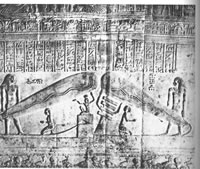The Dendera Lightbulb
in the crypt of Dendera temple (crypts were used as storage space for cult statues, which were probably made of gold, as well as other items used at certain festivals during the year, except at the New Year Festival when all cult statues were removed and placed in the appropriate room in the main temple. Apart from storage facilities the crypts also served a symbolic purpose and it appears the crypts were used as a refuge at times of external threat.
The crypts were identified with the "underworld". When the cult-statues were, in practical terms, being stored in the crypts during the non-festival periods, the statues were considered to be "life-less" and the "body" of the deity now rested as a "corpse" in the underworld. In this context it is interesting to consider the caches of statuary discovered buried in Luxor and Karnak Temples.
The "corpse", once brought out of the crypt had to be brought back to life through rituals. Certain statues were "processed" to live again through the "Opening of the Mouth" ceremony which was practiced in the Gold House situated close to the crypt.
there are inscriptions depicting a bulb-like object which some have suggested is reminiscent of a "Crookes tube" (an early lightbulb). Inside the "bulbs" a snake forms a wavy line from a lotus flower (the socket of the bulb). A "wire" leads to a small box on which the air god is kneeling. Beside the bulb stands a two-armed djed pillar, which is connected to the snake, and a baboon bearing two knives. In "The Eyes of the Sphinx", Erich Von Daniken suggested that the snake represented the filament, the djed pillar was an insulator, and the tube was in fact an ancient electric light bulb. The baboon was apparently a warning that the device could be dangerous if not used correctly.We do not know the exact origin of the Djed pillar, but its hieroglyphic meaning ("enduring" or "stability" and sometimes "column") is not doubted. There is no apparent connection between the concept of "enduring" and the process of insulating, but even if there was, it is my understanding that the Djed wouldn't work as an insulator. In a light bulb, the glass bulb itself insulates the filament, and no extra component is required.
The "cable" is described in the text beside the depiction as a symbolic sun barge moving across the sky (in a form which is by no means unique to these carvings). It seems to be a bit of a stretch to describe this as a cable, although I suppose you could argue that the movement of the sun mirrored the movement of electricity. However, the "cable" is attached to what proponents describe as a "socket", but is in fact a lotus flower. This flower appears in this form all over Egypt, and is always a lotus flower. Furthermore, the text beside the depiction confirms that it is a lotus flower.
Francois Daumas suggested that the sacred procession which was held on the eve of the first day of the New Year, began in these rooms. Thus the inscriptions represented the myth which was being celebrated. Of course, the myths have nothing to say regarding lightbulbs, and there is no evidence to substantiate their use from Egyptian remains or text. This is fairly damning as the building of huge stone monuments required the maintenance of detailed and thorough accounts, yet there is no record of any electric devices or the movement of raw materials to create them.
Some are still unwilling to entirely give up on the idea. Instead of claiming that the Egyptians used light bulbs under normal conditions, they suggest that the priests performed a ritual which created a small amount of light during the New Year celebrations. Proponents claim that the reliefs describe a three stage process; first the "bulb" is supported by a kneeling figure making three "waves" emanate from the serpent, then the "bulb" is supported by a Djed pillar making four "waves" emanate from the serpent, finally the "bulb" is placed against a vertical Djed pillar causing five "waves" to emanate from the serpents body. The waves are thought to be evidence of a vibratory process increasing in frequency as the scenes progress.
This is certainly a more creative theory which neatly avoids the lack of any supporting evidence by claiming that the ceremony was ritual and secret. The problem remains that all of the elements are known to have specific meanings from numerous other sources, and the text confirms those meanings. However, it is still possible that the priests encoded a deeper meaning in the text and images.















No comments:
Post a Comment